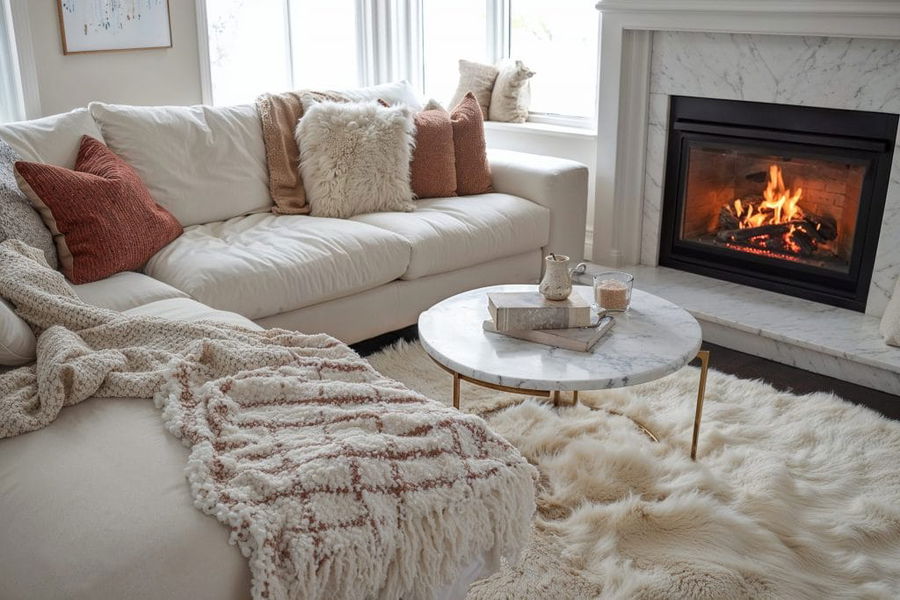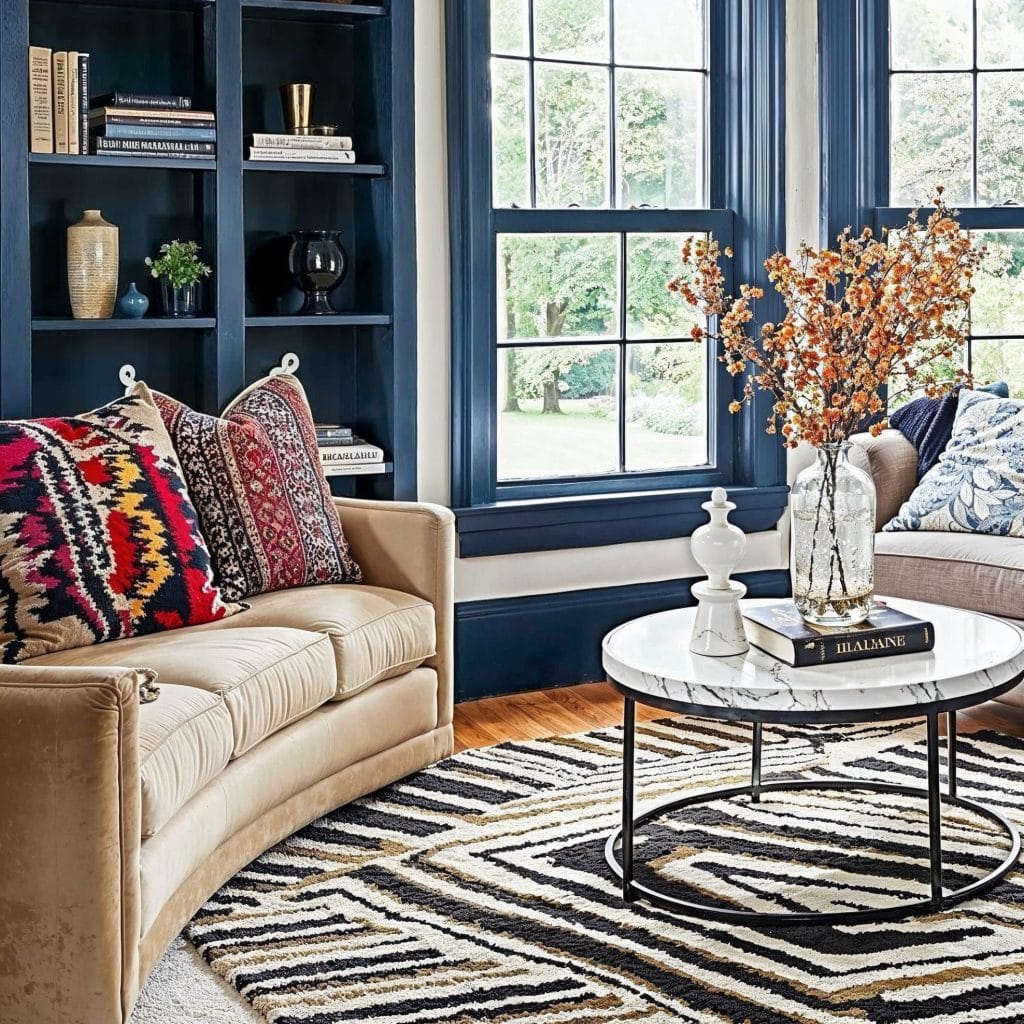
What to do when one big rug in a space just isn’t enough? Area rugs are an important part of interior décor, especially for multifunctional spaces. Combining them can make a true difference, so here are some layered rug living room tips to try.
1. Make It Warmer

Does your central home space feel too formal and unused? Many well-designed living rooms lack that lived-in comfort, leaving them admired but rarely enjoyed. To soften the tone, try layering rugs to create warmth and texture. A layered rug living room instantly feels cozier, especially when a plush, high-pile rug sits on top of a larger natural-fiber base.
Pro Tip: Want a layered rug living room but wondering what is the right look for you? Try our Free Interior Design Style Quiz to discover your ideal style today!
For added softness, choose rugs with different weaves or pile heights. Start with a jute or sisal base for stability, then top it with something more indulgent, like a Moroccan-inspired shag. Sometimes, even a smaller accent rug, placed strategically under a coffee table or armchair, can define a cozy corner while keeping the look intentional.
2. Work in a Fur or a Cowhide

Is your cowhide looking a little lonely and out of place in the corner of your living room? Few pieces make as bold a statement as a layered cowhide rug living room setup. Both fur and cowhide effortlessly inject character into minimalist spaces, especially when paired with wooden floors.
Start your living room rug ideas with a neutral sisal or woven base. Then, add a fur or cowhide rug to soften sharp contrasts, blending rustic charm with modern polish. To strike the right balance, position the base rug under the furniture while letting the cowhide partially overlay it. Then, to amplify texture, add a faux fur throw or a smaller sheepskin rug to seating areas. These pieces will complement the cowhide’s natural patterns, pulling the look together.
3. Cover Existing Carpeting

Are you over your carpeting but limited in removing it? Replacing carpet isn’t always an option, but layered living room rugs offer a quick fix. This hack disguises outdated or bland carpeting, which makes it a handy solution for rentals, too. Contrast is key—pair smooth carpets with thick rugs or subtle carpet tones with vibrant layered patterns
High-pile rugs like faux fur or shag add comfort, while flat-woven options bring in bold colors or intricate patterns. To prevent shifting and wrinkles, invest in rug-on-carpet pads designed to keep layers securely in place. Opt for heavier rugs that naturally resist movement, or layer multiple smaller rugs to create an eclectic collage effect.
4. Just Go With More

Did you go shopping for one rug and fall in love with quite a few? You don’t have to choose—layering multiple rugs expands design possibilities. Overlapping smaller rugs allows for playful combinations of color, pattern, and texture. Plus, a layered rug living room approach isn’t just about style—it’s practical, too. It let you adjust the visual scale of the room without the cost of custom carpeting.
Mix geometric prints with traditional motifs or balance bold designs with neutral layers underneath. If mixing patterns feels intimidating, use a unifying color palette to tie the pieces together. Or, combine round rugs under coffee tables with rectangular bases to break linear patterns or use overlapping corners to create an asymmetrical focal point. With the right balance, even an unconventional mix can look intentional and curated.
5. Balance the Room

Does the scale of your rug seem not quite right? Rugs should complement—not shrink—your space. If the current rug feels too small, layering offers an easy fix. Position a larger neutral base, like a jute or sisal rug, to frame the room, then layer a smaller, more detailed rug on top for visual intrigue. The layered approach defines areas without boxing them in, making even compact spaces feel expansive.
A layered rug living room design also helps integrate mismatched furniture. If your sectional feels oversized or your chairs too petite, rugs can balance the scale. For larger layouts, try overlapping multiple rugs in seating areas and dining spaces. This trick makes open-plan spaces feel purposeful, maintaining their flow at the same time.
6. Zone Out the Room

Does your living room need more structure without losing its openness? Layered rugs provide visual zoning, helping to define areas within larger living spaces. For example, a layered rug living room can anchor a seating area, while a textured flat-weave rug marks off a reading nook or work zone.
Pairing rugs of varying shapes or sizes highlights different purposes within the same room. Use a round rug under a coffee table to soften angular furniture, or layer multiple rectangular rugs to establish distinct zones without losing cohesion.
Need help designing the perfect layered rug living room?
Our expert interior designers specialize in creative layouts and textures that fit every style and budget. Book your Free Online Interior Design Consultation to get started today!












Comments